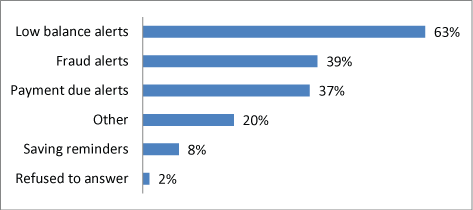Consumers and Mobile Financial Services
March 2013
- How Mobile Phones Affect Shopping Behavior
- Use of Mobile Phones in Financial Decisionmaking
- Conclusion
- Appendix 1: Technical Appendix on Survey Methodology
Use of Mobile Phones in Financial Decisionmaking
As the use of mobile banking increases, mobile phones are increasingly becoming tools for managing personal finances and controlling spending. For example, 64 percent of mobile banking users report using their mobile phone to check financial account balances or available credit before making a large purchase in the past 12 months. Of those who checked their balance or available credit, 53 percent report that they decided not to buy an item because of the amount of money in their bank account or the amount of available credit.Some mobile phone users actively manage their finances on their mobile phones: 10 percent report using their mobile phone to track purchases and expenses. Among those tracking their finances on their mobile phones, 36 percent use a mobile application for expense tracking, 12 percent use a spreadsheet, 35 percent use the web browser to access a website, 10 percent send text messages, and 19 percent take notes in a notepad or word processor.
Because many consumers have near constant access to their mobile phones, these devices have the potential to provide just-in-time information that can influence consumer financial behavior and help them to make different, and perhaps smarter, financial decisions. The actions consumers take in response to the receipt of text message notices from their financial institutions demonstrate some of the potential effects of this technology for encouraging consumers to engage in different financial behaviors that may prove to have beneficial outcomes.
Almost 30 percent of mobile banking users indicate that they receive text message alerts from their bank. Among those receiving alerts, 63 percent receive "low-balance alerts," 39 percent receive "fraud alerts," 37 percent receive "payment-due alerts," and 8 percent indicate that they receive "savings reminders" (figure 8). Consumers who receive a low-balance alert from their bank nearly all report taking some action in response: transferring money into the account with the low-balance (54 percent), reducing their spending (36 percent), or depositing additional money into the account (24 percent) (figure 9). Only 14 percent reported taking no action in response to receiving a low-balance alert.
Consumers also appear to respond to receiving payment due alerts by text message. Among those receiving payment due alerts, 50 percent reported that they improved their ability to pay their bills on time "by a lot," while an additional 27 percent reported that they improved their ability to pay their bills on time "by a little."

Note: This was question 72 in the survey (see Appendix 2); number of respondents was 168.
Figure 9. Thinking of the most recent low-balance alert you received by text message, which of the following actions did you take after receiving the alert?

Note: This was question 73 in the survey (see Appendix 2); number of respondents was 109.
